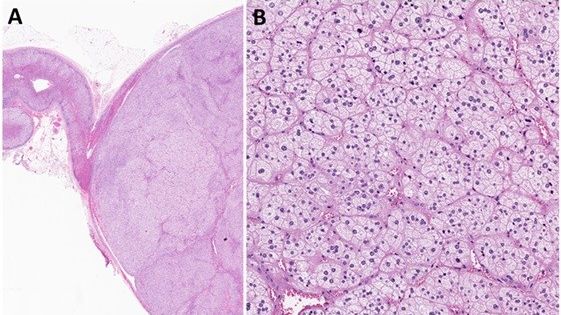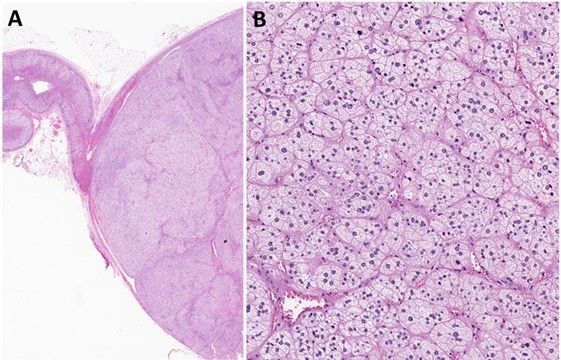
Press release -
Elucidating the Mechanism of Aldosterone Overproduction by Adenomas Presents Novel Hypertension Drug Target -- Kindai University
Osaka [6 July 2023] Researchers identify how mutations in the cell adhesion molecule 1 (CADM1) gene disrupts aldosterone production
The excessive production of the hormone aldosterone by tumors called "aldosterone-producing adenomas (APAs)" is the most common, curable, cause for hypertension. Now, a global consortium of researchers has pinpointed that non-inheritable mutations within the cell adhesion molecule 1 (CADM1) gene of these APAs inhibit communication between aldosterone-producing cells, resulting in hormonal overproduction. These findings provide a potent new target for the development of drugs to treat hypertension caused by APAs.
Hypertension can occur in patients due to primary aldosteronism (PA)—a condition caused by the excessive production of the hormone aldosterone. One of the causes of PA is the presence of tumors called aldosterone-producing adenomas (APAs) in the adrenal glands. Research has shown that somatic mutations—mutations in non-reproductive cells that are usually non-inheritable—in APAs determine their aldosterone production.
The most common somatic mutation found in patients with PA, especially in large APAs, are the pathogenic "potassium inwardly rectifying channel subfamily J member 5 gene (KCNJ5)" variants. However, APAs caused by other pathogenic variants are characterized by a much smaller size. These can be overlooked in diagnostic scans or considered harmless when evaluating adrenal tissue.
In a study published in Nature Genetics on 8 June 2023, researchers show that mutations in the cell adhesion molecule 1 (CADM1) also influence aldosterone production. These breakthrough findings implicate cell communication across adrenal cortex gap junctions (GJ) in the suppression of aldosterone overproduction. A global consortium of researchers contributed to this study, including Professor Akihiko Ito from Kindai University, Professor Yutaka Takaoka from University of Toyama, Professor Fumitoshi Satoh from Tohoku University, and Professor Morris Brown from Queen Mary University of London.
“We wanted to know if there were other mutations that characterized small APAs and if KCNJ5-mutant APAs weren’t the dominant genotype,” explains Prof. Ito, who led the study. “Being engaged in CADM1 research for over two decades, Prof. Brown reached out to me when he found a somatic CADM1 mutation in an aldosterone-producing adenoma. We were very keen to understand how this mutation influenced aldosterone production.”
The team employed a battery of experiments to probe the role of CADM1 in aldosterone production: APA exome sequencing (where all the protein-coding genes were sequenced); gene expression and knockdown studies; immunohistochemistry; immunofluorescence staining; in vivo studies using human H295R adrenocortical cell lines; gene transfection (where the host cell’s genetic makeup is modified by introducing a target sequence); RNA sequencing; hormone measurements; and drug treatment assays, among others.
APA exome sequencing data identified two CADM1 variants, p.Val380Asp and p.Gly379Asp, from two patients cured of hypertension and primary PA by adrenalectomy. Furthermore, the gene expression data revealed that CYP11B2, which encodes aldosterone synthase—one of the enzymes that helps synthesize aldosterone—was strongly upregulated when both CADM1 variants were introduced into H295R adrenocortical cells. The next set of results from the CADM1 knockdown and mutation assays revealed that GJ-permeable dye transfer in adrenocortical cells was blocked and CYP11B2 expression increased in the presence of the GJ inhibitor, Gap27. Lastly, CYP11B2 mutant cells displayed patchy GJA1—the main GJ protein—expression and less prominent defective GJs.
“These findings underpin a new mechanism by which CADM1 determines aldosterone production. This intercellular adhesion molecule goes beyond functioning merely as a glue and supports cellular communication that can suppress aldosterone production,” says Prof. Ito when asked to elaborate on the significance of the group’s findings.
What do the team’s findings mean for treating patients with hypertension? Dr. Ito concludes, “We feel that this work offers hope to patients who are diagnosed with drug-resistant hypertension and unable to manage their condition. As researchers make more breakthroughs on the mechanisms of aldosterone production, we could soon see the next generation of anti-hypertension drugs on the market!”
Reference
Title of original paper:Somatic mutations of CADM1 in aldosterone-producing adenomas and gap junction-dependent regulation of aldosterone production
Journal: Nature Genetics
DOI:10.1038/s41588-023-01403-0
URL:https://doi.org/10.1038/s41588-023-01403-0
Image

Title: Researchers reveal CADM1 mutations in an adrenocortical adenoma (pictured above) influence aldosterone overproduction—a contributor to hypertension
Caption: This study also validates the role of gap junction communication in the suppression of aldosterone production.
Image Credit: Ozgur Mete and Kai Duan
URL: https://commons.wikimedia.org/w/index.php?curid=91818708
License: CC BY-SA 4.0
About Kindai University
Kindai University was established in 1949 after the merger of Osaka Technical College (founded in 1925) and Osaka Science and Engineering University (founded in 1943). Over the past several decades, the university has transformed into a comprehensive educational organization with an ever-growing reputation. Kindai University has over 2,200 full-time faculty members, 6 campuses, and 18 research centers. As an academic institution offering a broad range of programs from across disciplines, Kindai University strives to impart practical education while nurturing intellectual and emotional capabilities. The university’s academic programs are fully accredited by Japan’s Ministry of Education, Culture, Sports, Science and Technology as well as by the National Institution for Academic Degrees and University Evaluation.
Website: https://www.kindai.ac.jp/english/
About Professor Akihiko Ito from Kindai University
Professor Akihiko Ito is a faculty member in the Department of Medicine and The Dean of Graduate School of Medical Sciences at Kindai University. His primary research interest is the molecular basis of cell adhesion and degeneration. Prof. Ito has been awarded numerous awards in his over 20-year career, including awards from the Japanese Society of Metastasis and the Japanese Society of pathology. He has published over 270 peer-reviewed articles since 1992 and has contributed to three books. He has also contributed to over 120 conference papers.
Funding information
This work was supported by the following UK funding bodies: National Institute for Health Research (NIHR, Efficacy and Mechanisms Evaluation project 14/145/09 to M.J.B., W.M.D., M.G.), the British Heart Foundation (Ph.D. studentship FS/14/75/31134 to M.J.B. supporting S.G.), Barts Charity (Project MGU0360 to M.J.B. and W.M.D.), NIHR Barts Biomedical Research Center (BRC-1215-20022 supporting M.J.B.), NIHR Integrated Academic Training Clinical Lectureship (to W.M.D. and M.J.B., supporting X.W.), NIHR Cambridge Biomedical Research Center (BRC-1215-20014 supporting M.G.), UKRI (MR/S007776/1 to F. Buss) and Wellcome Trust (104955/Z/14/Z to A.D.). E.A.B.A. was funded by the UK-MY Joint Partnership on Noncommunicable Diseases 2019 program (NEWTON-MRC/2020/002) and the Royal Society-Newton Advanced Research Fellowship (NA170257/FF-2018-033). C.P.C. was funded by the NIHR as part of the portfolio of translational research of the NIHR Biomedical Research Center at Barts and The London School of Medicine and Dentistry. E.G. was supported by a Medical Research Council (UK) Fellowship, MR/S006869/1. This research used Queen Mary’s Apocrita HPC facility (https://doi.org/10.5281/zenodo.438045), supported by QMUL Research-IT. Immunofluorescence images were acquired in the Blizard Advanced Light Microscopy Suite. The work in Japan was supported by the Japan Society for the Promotion of Science KAKENHI grants (18K07414 to Y. Takaoka, 17K08680 to M.H., 21K08557 to K.O., and 15K15113, 18K07049 to A.I.); the Ministry of Education, Culture, Sports, Science and Technology-Supported Program for the Strategic Research Foundation at Private Universities 2015-19 (to A.I.); a grant from Takeda Science Foundation (to M.H.); and grants from the Ministry of Health, Labour, and Welfare, Japan (20FC1020 to F.S.). M. Murakami was supported by the Japan Heart Foundation/Bayer Yakuhin Research Grant Abroad and an Uehara Memorial Foundation postdoctoral fellowship. The work in Paris was supported through institutional funding from Inserm, by the Agence Nationale de la Recherche (ANR-18-CE93-0003-01) and the Fondation pour la Recherche Médicale (EQU201903007864 to M.-C.Z). Other funding bodies include the National Medical Research Council and Biomedical Research Council, Singapore (to R.S.F.); the National Science Foundation grant MC-2011577 (to S.A.M.); the large research infrastructure project BBMRI.cz LM2023033 (to A.R.); Else Kröner-Fresenius-Stiftung in support of the German Conn’s Registry‒Else Kröner Hyperaldosteronism Registry (2013_ A182, 2015_A171 and 2019_A104 to M.R.), the European Research Council under the European Union’s Horizon 2020 research and innovation program (grant agreement 694913; to M.R. and grant agreement 633983 to F. Beuschlein), the Deutsche Forschungsgemeinschaft (DFG) within the CRC/Transregio 205/1 ‘The Adrenal: Central Relay in Health and Disease’ to M.R. and F. Beuschlein, and by the Clinical Research Priority Program (CRPP HYRENE) and the University Research Priority Program (URPP ITINERARE) of the University of Zurich (to F. Beuschlein).

